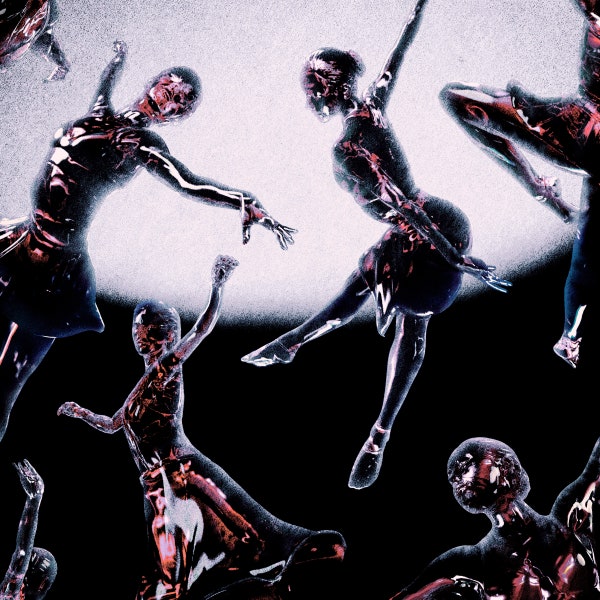‘Optimist’ lacks originality and fails to impress
FINNEAS’ debut album falls short of the bar he set in his previous music

Photo courtesy of AWAL/Interscope Records
The cover of FINNEAS’ debut album, “Optimist,” features several dancing figures suspended in air.
October 25, 2021
he debut studio album of singer-songwriter and producer FINNEAS (Finneas Baird O’Connell), “Optimist,” was released on Oct. 15, 2021. FINNEAS initially rose to fame due to his work producing and co-writing for his younger sister Billie Eilish’s (Billie Eilish Pirate Baird O’Connell). His first solo record was the pop EP “Blood Harmony,” which he released in October of 2019. The EP’s lead single, “Let’s Fall in Love for the Night,” peaked at No. 17 on the Billboard Alternative music chart and cemented FINNEAS’ position as a solo artist.
Throughout the 13 tracks of “Optimist,” FINNEAS delves deeper into hyperpop and electronic-based sounds than he did on “Blood Harmony.” Ironically, the album’s title is a misnomer, as FINNEAS shows more cynicism than optimism in the lyrics. Both the new sound and the new direction veer away from the lovelorn, relationship-driven songs that listeners associate with FINNEAS. Instead, “Optimist” widens the scope to reveal FINNEAS’ disenchantment with society as a whole.
“A Concert Six Months From Now” — 3/5

“A Concert Six Months From Now,” the first track of “Optimist,” eases listeners into the album, as it is reminiscent of FINNEAS’ previous work on “Blood Harmony.” A love song, this first track’s lyrics are where FINNEAS uses details about the past and the present of a relationship to confess emotions about an ex, revealing that the pair’s story is not as straightforward as it initially seems.
The lyrics of the chorus, “If I could see the future / I never would believe her / Fallin’ in and out of love and fallin’ in again / We were never any good at bein’ friends” make the pair’s relationship ambiguous — their difficulty at being friends could be because they’re enemies or because they can’t help being more than friends. Additionally, the shifts between verb tenses as FINNEAS jumps between referencing the past, present and future throughout the song blur the timeline of this relationship even further. The result is an atmosphere of haziness and messy entanglement that is ultimately the track’s best quality.
In terms of musical composition, the majority of the song remains constant — a steady strum of guitar supports FINNEAS’ low, sultry vocals and adds to the sensation of cloudy thoughts. However, during the second verse, listeners are bombarded with the sudden input of bass that dramatically changes the tone. While this may have been added to the song to resemble an onslaught of emotion, its abruptness and short length ultimately adds nothing to the song except discordancy.
“A Concert Six Months From Now” was written in 2017, and it shows — the track’s tone and message is more similar to FINNEAS’ EP “Blood Harmony” than it is to its own album, and any attempts to relate it to the rest of “Optimist” through unique production decisions ultimately fall flat. “A Concert Six Months From Now” isn’t a bad song, but it shouldn’t have a place on “Optimist.”
“The Kids Are All Dying” — 3.5/5
In “The Kids Are All Dying,” the second track on “Optimist,” features an upbeat song accompanied by FINNEAS’ cynical take on society’s flaws. The highlight of the song is FINNEAS’ lyricism, in which he conveys messages about the detriments of capitalism and internet culture in a sarcastic manner. FINNEAS’ dry humor simplifies controversial topics like climate change and consumer culture in a way that makes them easy for listeners to understand, with lyrics like, “Bang bang / Knocking on my door / ‘Do you have a dollar? Would you like to fund a war?’”

The nature of the lyrics combined with the upbeat nature of the song contrast the meaning of the lyrics, which allude to FINNEAS’ thoughts about humankind as a whole. The beginning of the chorus, “How can you sing about love when the kids are all dying” is first accompanied by silence. Then, the line is punctuated by a beat drop composed of four repeated piano notes and drums. The rest of the chorus follows this same format — a statement punctuated by a beat drop to emphasize its value.
In the bridge of the song, FINNEAS acknowledges his hypocrisy in criticizing racism and capitalism as a beneficiary and perpetrator of them, with lyrics like, “I’m whiter than the ivory on these keys” and “Drink my wallet and drive my wealth.” The lyrics ultimately make FINNEAS’ apology come off as insincere and disingenuous.
The song ends quite abruptly — FINNEAS sings half of the first verse before the music fades out with one last piano chord. Though the lyricism is witty and the tune of the song is catchy, “The Kids Are All Dying” fails to provide original insights and falls short following the bridge, failing to deliver a satisfying ending.
“Only A Lifetime” — 2/5
“Only A Lifetime,” the fourth track on “Optimist,” features a slow ballad preaching about valuing time with loved ones to emphasize that a lifetime is too short to waste. This sentiment isn’t new, and FINNEAS’ lyrics once again fail to provide original insight either. He advises, “It’s only a lifetime, that’s not long enough / You’re not gonna like it without any love, so don’t waste it.” The vague and somewhat superficial lyrics don’t contribute anything to the track overall, and the simple but uninteresting backing track leaves the song with one standout feature — FINNEAS’ vocals.
Though not very complex or interesting, FINNEAS’ vocals throughout the song are mellow and soothing. His falsetto throughout the chorus is melodious and his vocals are highlighted throughout the song as the backing track is relatively quiet. However, his lyrics leave nothing to analyze and aren’t enough to make up for the overall boring lyricism and song production. It’s also one of five instrumental ballads on the album, and doesn’t have much uniqueness to set it apart from the rest of them.
“The 90s” — 5/5
“The 90s,” the fifth track and third single on “Optimist,” is unlike any song FINNEAS has released before — it’s categorized as electronic pop. Although FINNEAS expresses his nostalgia and longing to go back to the ‘good old days’ of the 1990s through poignant lyrics such as, “I think about the 90s / When the future was a testament / To something beautiful and shiny, now / We’re only countin’ down the time that’s left,” the moving message and electronic-based music contrast exceedingly well.
The standout feature of the track is its production. The autotune chorus is an intriguing choice for FINNEAS — he is, after all, known for his heart-wrenching ballads. Yet, it ultimately emphasizes the message, as its futuristic, almost soulless feeling mirrors the way FINNEAS laments the drudgery of the current times. The first verse consists mainly of FINNEAS’s vocals rather than any real music. In the second verse, however, more sounds are added, giving the sensation that FINNEAS is going from simply feeling wistful to aching for the past.
However, the true highlight of “The 90s” is its bridge, when the music suddenly turns to electronic rock. Albeit jarring, it only takes a few repeats for listeners to be holding their breaths, eagerly anticipating the beat in this part drop. Overall, the steady build-up of sound until the bridge adds a layer of emotionality to the track — the abrupt beat drop reflects the way that being reminded of childhood memories can cause waves of nostalgia and melancholy to crash against a person and make them realize how their life has changed over the years.
“The 90s” is undeniably a standout track on the album, not only due to its distinct sound, but also because it showcases FINNEAS’s incredible producing ability to intertwine seemingly contradictory elements to create an even more meaningful song.
ALBUM REVIEW
For a debut studio album, “Optimist” is mediocre. The overall tone of the album mostly remains cohesive, and FINNEAS attempts to add eccentricities to make each track distinct. However, FINNEAS is already well-known for his work on Billie Eilish’s music — production that has been incredibly thoughtful and creative — and his own solo album ultimately falls short of the quality of music it’s clear that he’s capable of. “Optimist,” with its electronic production and, at times, near-pessimism sounds like a weak emulation of Eilish’s music — music that he created.
Additionally, “Optimist,” despite its name, is overcast with gloominess as FINNEAS continually finds faults in various aspects of life. The songs’ messages can become repetitive after multiple listens — “The Kids Are All Dying,” “Happy Now?” and “Only A Lifetime” echo each other’s message in progressively less interesting ways.
FINNEAS set himself apart from his sister with “Blood Harmony” — he was the more optimistic and romantic of the two. Ironically, “Optimist” feels like a step backwards — he is incredibly adept at writing engaging, nuanced love songs, yet his debut album shows none of that skill. In the end, “Optimist” as a standalone album does not have glaring flaws. However, listeners familiar with his work can’t help but think — was this really the best FINNEAS could do?
2.5/5


















